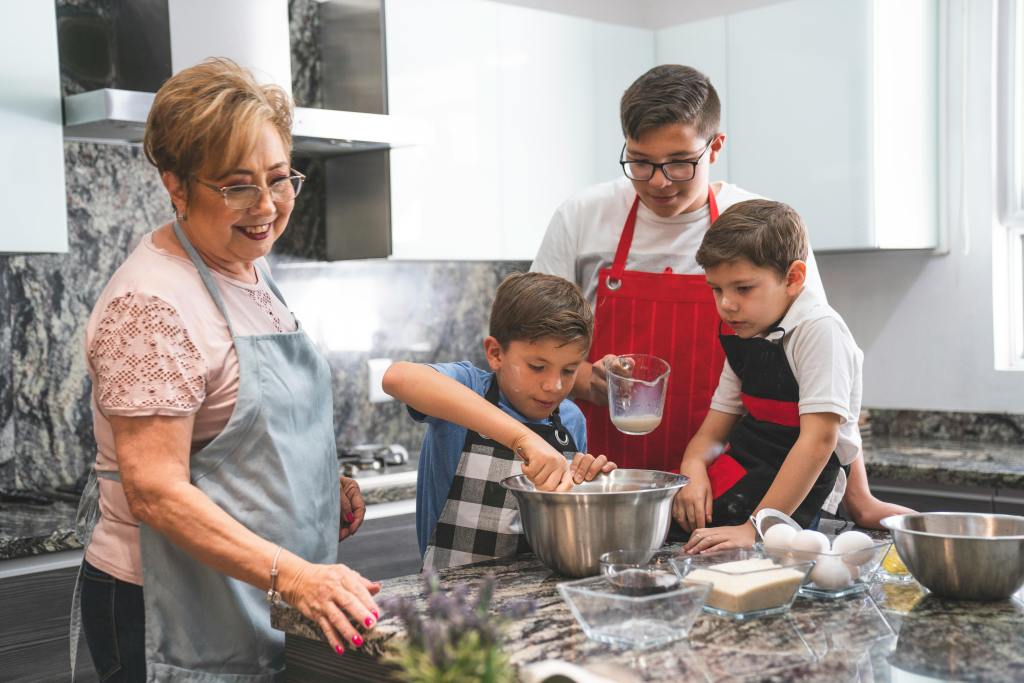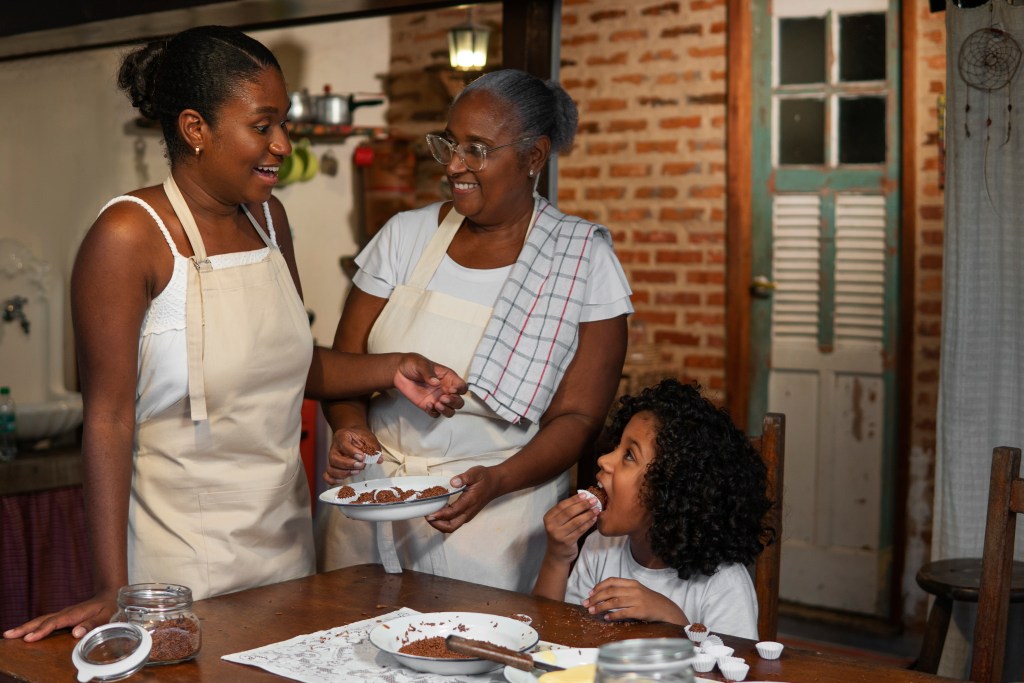
by Sarah Noel
There’s something deeply nostalgic about the smell of simmering garlic from the kitchen, the thump of a basketball in the driveway, and the faint sound of classical music wafting from the den where Grandpa dozes off mid-sudoku. If you live in a home that houses grandparents, parents, and children, you know that magic—and occasional madness—of a multigenerational household. It’s not always graceful, but it can be richly rewarding. Making that harmony happen, though, doesn’t come with a pre-written script. You’ve got to write it yourself, one respectful compromise at a time.
Respect Starts With Space
 You may all love one another deeply, but love doesn’t always translate into functional
You may all love one another deeply, but love doesn’t always translate into functional
living. Nothing tests affection quite like shared square footage. The key here is to carve out personal zones for everyone—literal physical zones, not just metaphorical ones. Maybe Grandma needs a quiet reading corner that doesn’t double as a kids’ LEGO battlefield. Or your teenager needs a door that doesn’t open without a knock, even if his “room” is technically the basement. Everyone in the house needs a place to retreat and breathe, where their boundaries are honored and their quirks aren’t up for commentary.
Kitchen Politics Are Real
 You wouldn’t think the refrigerator could stir drama, but it does. Whether it’s Grandma’s homemade pickles mysteriously vanishing or your toddler’s string cheese ending up in Grandparents’ midnight snack rotation, kitchen diplomacy matters. Consider separate food zones or labeled storage when possible, and talk openly about grocery needs and dietary quirks. Does Nana insist on cooking dinner every night even though you’ve been dying to test that Ottolenghi recipe? Rotate cooking duties, or better yet, cook together. Food is emotional terrain in any family, but it’s practically sacred ground in a multigenerational home.
You wouldn’t think the refrigerator could stir drama, but it does. Whether it’s Grandma’s homemade pickles mysteriously vanishing or your toddler’s string cheese ending up in Grandparents’ midnight snack rotation, kitchen diplomacy matters. Consider separate food zones or labeled storage when possible, and talk openly about grocery needs and dietary quirks. Does Nana insist on cooking dinner every night even though you’ve been dying to test that Ottolenghi recipe? Rotate cooking duties, or better yet, cook together. Food is emotional terrain in any family, but it’s practically sacred ground in a multigenerational home.
Safeguarding the Shared Home
In a house where multiple generations rely on the same appliances and systems,
breakdowns are not just inconvenient—they ripple across the entire routine. Protecting your finances with a home warranty can help soften the blow when the fridge goes warm or the furnace gives out midwinter. It’s worth finding coverage that includes removal of defective equipment and accounts for breakdowns caused by improper installations or past repairs, since those issues tend to surface in older, lived-in homes. If your family’s trying to build stability under one roof, this is a practical option.
Not All Chores Are Created Equal
 Forget chore wheels—they are cute but rarely sustainable when a household spans three generations. Instead, play to your strengths. Grandpa may be slow to climb stairs, but happy to mend broken hinges. Your teenager might grumble through unloading the dishwasher, but will help Grandma connect to Zoom faster than you can say “update required.” Household contributions shouldn’t be equal; they should be equitable. And acknowledge the invisible labor, too—like the emotional support a grandparent provides just by being present. Gratitude goes further than assignments.
Forget chore wheels—they are cute but rarely sustainable when a household spans three generations. Instead, play to your strengths. Grandpa may be slow to climb stairs, but happy to mend broken hinges. Your teenager might grumble through unloading the dishwasher, but will help Grandma connect to Zoom faster than you can say “update required.” Household contributions shouldn’t be equal; they should be equitable. And acknowledge the invisible labor, too—like the emotional support a grandparent provides just by being present. Gratitude goes further than assignments.
Routines Are Anchors, Not Shackles
It’s easy to fall into the trap of rigid scheduling to keep the peace. But structure isn’t about control—it’s about predictability. Establishing regular family rituals—shared Sunday breakfasts, evening check-ins, movie nights—can help everyone feel anchored without feeling micromanaged. At the same time, flexibility is your friend. Sometimes, Grandpa’s doctor appointment collides with your Zoom presentation and your kid’s soccer game. Everyone’s rhythm will occasionally clash. The trick is to expect it and adapt, not melt down in the face of it.
Generations Need Generous Listening
 If you grew up with a grandparent saying, “Because I said so,” then the concept of reciprocal listening might feel foreign. But if you’re living under the same roof, you can’t afford to ignore each other’s perspectives. Kids want autonomy. Parents want respect. Grandparents want relevance. Sometimes that means listening to a story you’ve heard twelve times because it makes someone feel seen. Other times it means letting go of control when your teenager makes a weird fashion choice or your mother offers unsolicited parenting advice. Everyone wants to be heard. Listening is your most valuable currency.
If you grew up with a grandparent saying, “Because I said so,” then the concept of reciprocal listening might feel foreign. But if you’re living under the same roof, you can’t afford to ignore each other’s perspectives. Kids want autonomy. Parents want respect. Grandparents want relevance. Sometimes that means listening to a story you’ve heard twelve times because it makes someone feel seen. Other times it means letting go of control when your teenager makes a weird fashion choice or your mother offers unsolicited parenting advice. Everyone wants to be heard. Listening is your most valuable currency.
Celebrate the Weirdness
No two households like this are the same, so stop comparing yours to some imagined
version of what a “perfect” multigenerational family should be. Maybe your kid calls your dad “Dude” and it weirds out your mom. Maybe the dog only listens to Grandma’s commands in Portuguese. Maybe your partner never imagined raising children in front of an audience. These things make your home yours. Embrace the awkwardness, the inconsistencies, the rerouted expectations. That’s where the soul of your family lives.
Living in a multigenerational home is not a consolation prize or a logistical solution. It’s a decision to knit your lives more tightly than many families dare to. That closeness comes with friction, yes, but also with the richness no solo apartment can offer. You’re not just managing a household—you’re weaving a living, breathing, multichapter story. If you write it with curiosity, patience, and humor, you’ll have more than just a roof over your heads. You’ll have a place where history meets hope, every single day.
Discover empowering insights and practical tips for living your best life at “thisisyourbestyear”, where every age is celebrated with grace and wisdom!